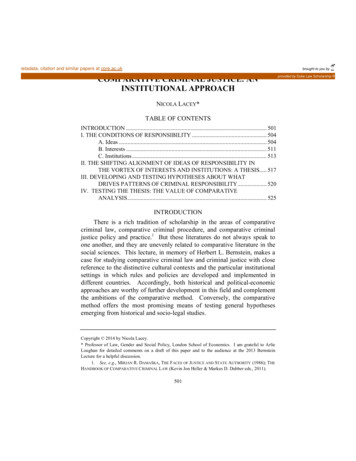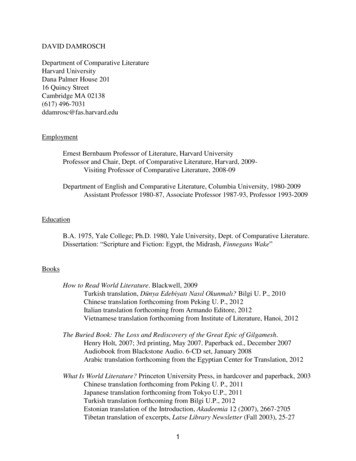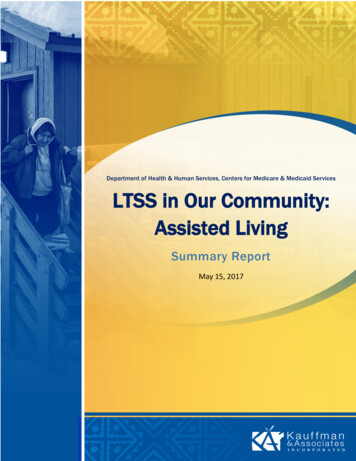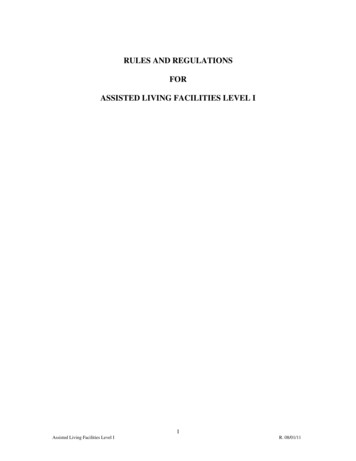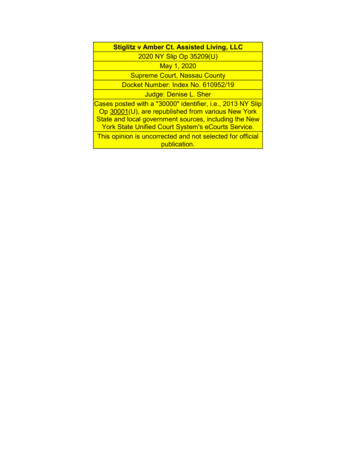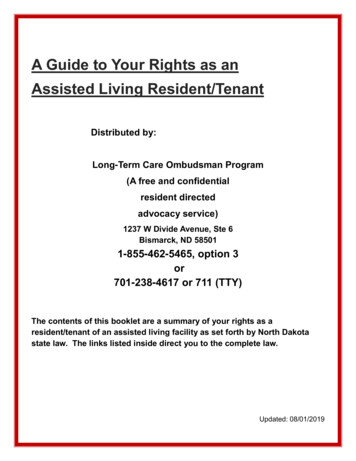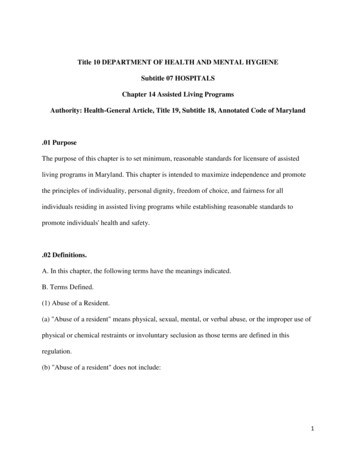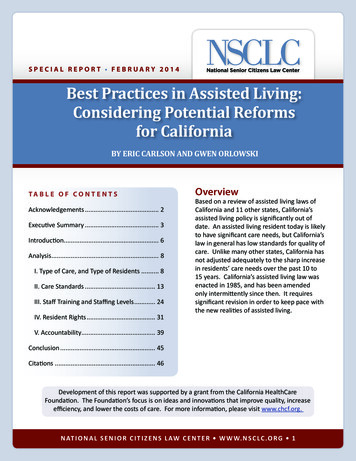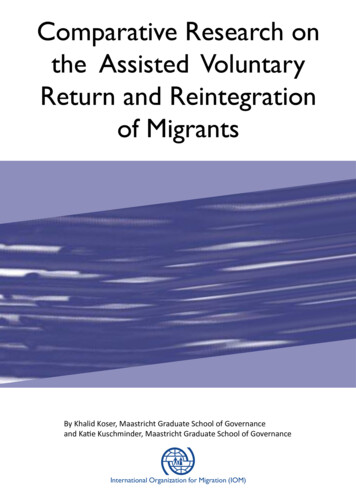
Transcription
Comparative Research onthe Assisted VoluntaryReturn and Reintegrationof MigrantsBy Khalid Koser, Maastricht Graduate School of Governanceand Katie Kuschminder, Maastricht Graduate School of GovernanceIOM OIMInternational Organizationfor Migration (IOM)
The opinions expressed in the report are those of the authors and donot necessarily reflect the views of the International Organization forMigration (IOM). The designations employed and the presentation ofmaterial throughout the report do not imply the expression of anyopinion whatsoever on the part of IOM concerning the legal status ofany country, territory, city or area, or of its authorities, or concerningits frontiers or boundaries.IOM is committed to the principle that humane and orderly migrationbenefits migrants and society. As an intergovernmental organization,IOM acts with its partners in the international community to:assist in meeting the operational challenges of migration; advanceunderstanding of migration issues; encourage social and economicdevelopment through migration; and uphold the human dignity andwell-being of migrants.This report has been published without formal editing by IOM.This research was commissioned by the Australian Department of Immigration and Border Protection as part of itsbroader Irregular Migration Research Programme. The opinions, comments and analyses expressed in this report arethose of the authors and do not necessarily reflect the views of the Department.AcknowledgementsThe authors would like to acknowledge the hard work and support of the other members of the project managementteam (Gervais Appave, Noëlle Darbellay, Ana Fonseca, Marie McAuliffe and Alex Parrinder) as well as Julie Bauer,Susanne Klink, Frank Laczko and IOM colleagues in Afghanistan, Australia, Bangladesh, Ethiopia, Greece, Indonesia,Iraq, Pakistan, Sri Lanka, Sudan, Switzerland, Turkey, Viet Nam, Refugee Action colleagues in the UK, and Ministry ofSecurity and Justice Repatriation and Departure Services colleagues in the Netherlands involved in the study.Publisher: International Organization for Migration17 route des Morillons1211 Geneva 19SwitzerlandTel: 41.22.717 91 11Fax: 41.22.798 61 50E-mail: hq@iom.intInternet: http://www.iom.int 2015 International Organization for Migration (IOM)All rights reserved. No part of this publication may bereproduced, stored in a retrieval system, or transmittedin any form or by any means, electronic, mechanical,photocopying, recording, or otherwise without the priorwritten permission of the publisher.
Comparative Research onthe Assisted Voluntary Returnand Reintegration of MigrantsBy Khalid Koser, Maastricht Graduate School of GovernanceandKatie Kuschminder, Maastricht Graduate School of GovernanceWith assistance by: Paul Hayes, Sarah Langley, Marie McAuliffe, Elaine McGregor, Victoria Mence, AlexParrinder, Nora Ragab, Georgina Sturge, Michaella Vanore, Vivianne van der Vorst, and Marieke van HouteIOM OIMInternational Organizationfor Migration (IOM)
Contentsi. List of figures. 6ii. List of tables. 6FOREWORD. 7EXECUTIVE SUMMARY. 81. INTRODUCTION. 101.1 Background. 101.2 Focus of this report. 101.3 Aims and objectives. 101.4 Structure of the report. 112. REVIEW OF THE LITERATURE. 122.1 Introduction. 122.2 Understanding the migrant return decision. 122.3 Defining and measuring sustainable return. 142.4 Factors determining reintegration and the sustainability of return. 152.5 Conclusions and next steps. 183. METHODOLOGY. 193.1 Introduction. 193.2 Choice of study countries and respondents. 193.2.1 Destination countries. 193.2.2 Origin countries. 193.2.3 Transit countries. 203.3 Method of information collection. 203.4 Recruitment of participants. 213.5 Methodological challenges. 233.6 Conclusions. 244. OVERVIEW OF STUDY COUNTRIES AND PARTICIPANTS. 254.1 Introduction. 254.2 Destination countries overview. 254.3 Transit countries overview. 284.4 Origin countries overview. 324.5 Profile of the respondents. 334.6 Assisted voluntary return programmes. 364.7 Conclusions. 375. UNDERSTANDING THE DECISION TO RETURN. 385.1 Introduction. 385.2 Model of the return decision-making process. 385.3 Factors influencing the return decision. 395.4 Conditions in the origin country. 405.5 Conditions in the destination country. 405.6 Individual factors. 415.7 Family/community level factors. 435.8 Policy interventions. 445.9 Information. 455.10 Conclusions. 454
6. DEFINING AND MEASURING SUSTAINABLE RETURN. 476.1 Introduction. 476.2 Defining sustainable return. 476.3 An analytical framework for measuring sustainable return. 486.4 Applying the return and reintegration index. 496.5 Return and reintegration index comparative analysis by origin country. 516.5 Conclusions. 527. PROMOTING REINTEGRATION AND SUSTAINABLE RETURN. 537.1 Introduction. 537.2 Individual factors. 537.3 Experiences prior to migration. 547.4 Experiences in the destination country. 577.5 Community of return. 587.6 Conclusions. 598. LINKING THE RETURN DECISION WITH SUSTAINABLE RETURN. 618.1 Introduction. 618.2 The decision to return and reintegration. 618.3 Return, reintegration, and re-migration. 638.4 Conclusions. 649. CONCLUSIONS. 659.1 Summary. 659.2 Policy implications. 659.2.1 Influencing the decision to return. 669.2.2 Measuring sustainability. 669.1.3 Promoting sustainable return and reintegration. 669.3 Conclusions. 67BIBLIOGRAPHY. 68ANNEXES. 73Appendix 1: Literature review. 73Appendix 2: Origin country questionnaire: Summary of responses . . 89Appendix 3: Transit country questionnaire: summary of responses. 127Appendix 4: Destination country questionnaire: Summary of Responses. 153Appendix 5: Afghanistan country report. 175Appendix 6: Bangladesh country report. 189Appendix 7: Ethiopia country report. 205Appendix 8: Iraq country report. 221Appendix 9: Pakistan country report. 237Appendix 10: Sri Lanka country report. 253Appendix 11: Sudan country report. 269Appendix 12: Viet Nam country report. 287Appendix 13: Transit countries report. 303Appendix 14: Destination countries report. 323Appendix 15: Proposals for further research. 3395
List of figuresFigure 2.1: Factors determining the decision to return. 13Figure 4.1: Number of asylum applications by destination country, 2004–2013. 26Figure 4.2: New asylum applications in 2013 by country of origin and destination. 27Figure 4.3: Total number of assisted voluntary return by destination country, 2004–2013. 28Figure 4.4: Top ten countries for AVR in by destination country, 2013. 29Figure 4.5: Number of asylum applications by transit country, 2004–2013. 30Figure 4.6: UNHCR caseload in 2013 by country of origin and transit. 31Figure 4.7: Total number of AVRs by transit country, 2010–2013. 32Figure 4.8: Number of asylum applications by origin country, 2000–2013. 33Figure 4.9: Total number of assisted voluntary return by origin country, 2000–2013. 34Figure 5.1: Factors determining the decision to return. 39List of tablesTable 2.1: Key variables that may influence reintegration and the sustainability of return. 17Table 3.1: Origin countries participant recruitment. 22Table 3.2: Number of interviews per country. 23Table 4.1: Top countries for assisted voluntary return by transit country, 2013. 32Table 4.2: Overview of all participants. 35Table 4.3: Countries of origin of participants in transit countries. 36Table 4.4: Countries to which participants in origin countries had returned from. 36Table 4.5: Types of migrants eligible for assisted voluntary return in the destination and transit countries. 37Table 5.1: Decision-making factors by category, all countries. 40Table 5.2: Number of individuals choosing each decision-making factor, all countries. 41Table 5.3: Decision regarding return, by personal characteristics and migration indicators (frequencies), destinationand transit countries only. 43Table 5.4: Involved in decision-making factors regarding return (multiple responses possible). 45Table 5.5: Information on assisted voluntary return (AVR) programmes. 46Table 6.1: Return and reintegration index. 52Table 6.2: Return and reintegration index by country of return. 52Table 7.1: Reintegration, by demographic characteristics. 55Table 7.2: Reintegration, by situation prior to migration. 56Table 7.3: Sustainable return, by migration experience. 57Table 7.4: Reintegration, by destination country. 58Table 7.5: Reintegration, by situation in destination country. 59Table 7.6: Reintegration, by living context upon return. 60Table 8.1: Decision to return and reintegration. 63Table 8.2: Desire to re-migrate and reintegration. 646
FOREWORDReturn migration is an integral and crucial component of international migration. Return is a critical focus of manygovernments’ migration policies, including through assisted voluntary return and reintegration programmes, such asthose delivered by IOM1. However, recent research on migrant decision making in relation to return is scarce and theexisting evidence base is insufficient to reliably inform or support the development and implementation of effectivereturn migration policies.There are important gaps in knowledge about the key factors that lead migrants to decide to return and the role ofpolicy interventions in their decision making processes. Furthermore, although significant international attention hasbeen paid to reintegration and sustainable return as key factors within assisted voluntary return and reintegrationframeworks, these concepts do not appear to have been consistently defined, or measured by the same indicatorsin different contexts – both across borders (including in different destination, transit and origin countries) and acrossprogrammes – making it difficult to reliably assess and comparably measure the effectiveness of approaches to return.This study intends to address some of these issues and thus inform a more consistent approach to gathering data andevidence, as well as the development of better frameworks for defining and measuring approaches to voluntary returnand reintegration policies and programmes.This research project was implemented through a highly effective collaborative partnership between: the AustralianGovernment Department of Immigration and Border Protection, operating under its Irregular Migration ResearchProgramme, which is aims to strengthen the evidence base on irregular migration to better inform policy andoperational deliberations; Khalid Koser, Katie Kuschminder and a team of researchers from Maastricht University,applying knowledge and expertise in migration research and ensuring the research was conducted independentlyand objectively; and the International Organization for Migration (IOM), building upon its expertise on managingassisted voluntary return and reintegration services globally and thus able to provide access to data, beneficiaries andstakeholders in countries of origin, transit and destination and to assist in facilitating in-country fieldwork.The study refers to the need for well-functioning monitoring and evaluative frameworks in voluntary return andreintegration programmes. It reflects the challenges associated with assistance in most cases being provided on ashort term basis only, which makes it extremely difficult for IOM and other implementing actors to stay in touch withreturnees for longer term monitoring and evaluation.With regard to future research, the study not only identifies remaining gaps to be addressed but also provides aninnovative, multi-dimensional tool to measure whether and in what ways returnees have reintegrated. While thereturn and reintegration index that has been developed needs to be further tested and adapted through futureresearch, based on conditions on the ground that may contribute to or hinder reintegration in particular circumstances,it is an important contribution that may assist in informing a consistent approach to the assessment of return andreintegration, including the development of monitoring and evaluation frameworks and approaches to analyzing theimpact of different reintegration packages in a more systematic way.This collaborative approach to international comparative analysis represents an important milestone in research onassisted voluntary return and reintegration. It clearly demonstrates the value for IOM, states and migration academicsof further research utilizing survey methodologies that can build on and expand the comparative scope of the project’sfindings, and can contribute to informing migration management and governance as well as better approaches toproviding meaningful and effective assistance to migrants.Bernd HemingwayDirector, Department of Migration Management1Assisted Voluntary Return and Reintegration (AVRR) is a key domain of IOM s work with migrants, civil societies and governments. Each year IOM assists around40,000 migrants to return to their countries of origin through AVRR programmes with diversified levels of assistance towards their return and reintegration.7
EXECUTIVE SUMMARY1. Sustainable voluntary return of migrants back to their origin countries is an important aspect of comprehensivemigration management; yet it is not always clear whether and how policy enables return or promotes sustainablereturn and reintegration. A lack of accessible data and a lack of consensus on how to define key concepts such assustainability make it difficult to assess the impact of assisted voluntary return policies; and their impact also variesacross different types of migrants and settings.2. This report presents the findings of a study that explored the factors influencing the decision to return, includingthe role played by return policy interventions. The study also aimed to enhance understanding of the concept ofsustainable return, how to define it, and how to measure it. The study was conceived and commissioned as partof the Australian Government Department of Immigration and Border Protection’s Irregular Migration ResearchProgramme and supported by the IOM. It involved fieldwork across 15 countries of origin, transit and destination;and is one of the largest comparative projects on this topic in recent years. At the same time, however, the samplesize of respondents in each country is relatively small and this study is intended as a preliminary research projectto test a new methodology that requires further expansion and testing.3. An extensive literature review identifies gaps in knowledge and evidence; forms the basis for survey design anddata analysis in this study; and exposes a number of policy assumptions that are not always supported by theexisting evidence. Most of the research on the return decision-making process, for example, indicates that theremoval of root causes may not be sufficient to ensure sustainable return. There is a degree of consensus inthe research that the availability of assistance is not a key factor in determining whether migrants will returnvoluntarily. And there is no clear evidence that reintegration assistance reduces the propensity to re-migrate.4. Semi-structured interviews were conducted with 273 respondents in eight origin countries (Afghanistan,Bangladesh, Ethiopia, Iraq, Pakistan, Sri Lanka, Sudan, Viet Nam), three transit countries (Greece, Indonesia,Turkey) and four destination countries (Australia, Switzerland, the Netherlands, UK). These countries were selectedfor various reasons, including relevance to the Government of Australia; scale of asylum and return flows; andvariety of assistance policies and programmes. In origin countries, interviews were conducted mainly with peoplewho had returned at least 12 months prior. In transit and destination countries respondents were identified bysupport agencies, and on the whole had already expressed an interest in return. Overall significantly more menthan women were interviewed. It was not possible systematically to compare return intentions and experiencesacross different return policies and programmes.5. In this study the individual return decision is conceived as being influenced by: ‘structural’ conditions (conditionsin the origin, transit, and destination country); individual conditions including individual attributes and socialrelations; and policy interventions. Overall respondents ranked the main categories of factors influencing theirreturn decision as fo
and Katie Kuschminder, Maastricht Graduate School of Governance International Organization for Migration (IOM)IOM OIM. The opinions expressed in the report are those of the authors and do not necessarily reflect the views of the International Organization for Migration (IOM). The designations employed and the presentation of



